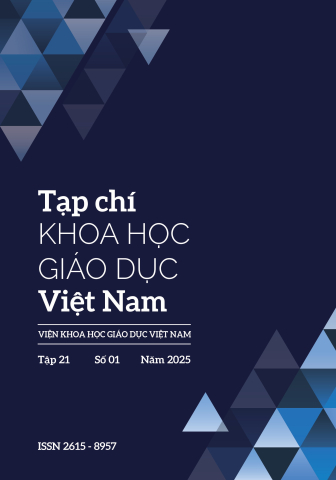[1] Aktan, S., (2012), Öğrencilerin akademik başarısı, öz düzenleme becerisi, motivasyonu ve öğretmenlerin öğretim stilleri arasındaki ilişki, Doktora tezi, Balikesir Üniversitesi.
[2] Leo, F. M., Mouratidis, A., Pulido, J. J., LópezGajardo, M. A., & Sánchez-Oliva, D., (2022), Perceived teachers’ behavior and students’ engagement in physical education: the mediating role of basic psychological needs and self-determined motivation, Physical Education and Sport Pedagogy, 27(1), 59–76, https://doi.org/10.1080/17408989.2020.1850 667.
[3] Yeşilyurt, E., Okudan, Ü., & Kizilaslan, B, (2020), Teaching style models: A comprehensive review in the context of theoretical basics, The Journal of International Social Research, 13(72), 722–745.
[4] Chan, S., Maneewan, S., & Koul, R, (2023), Teacher educators’ teaching styles: relation with learning motivation and academic engagement in pre-service teachers, Teaching in Higher Education, 28(8), 2044–2065, https://doi.org/10.1080/13562517.2021. 1947226.
[5] Cornelius-White, J, (2007), Learner-centered teacherstudent relationships are effective: A meta-analysis, Review of Educational Research, 77(1), 113–143, https://doi.org/10.3102/003465430298563.
[6] Ünal, M., (2017), Analysis of teaching styles of teachers and prospective teachers in terms of different variables, Abant İzzet Baysal Üniversitesi Eğitim Fakültesi Dergisi, 17(2), 932–947.
[7] Yoshida, F., Conti, G. J., Yamauchi, T., & Iwasaki, T., (2014), Development of an instrument to measure teaching style in Japan: The teaching style assessment scale, Journal of Adult Education, 43(1), 11–19.
[8] Fischer, B. B., & Fischer, L., (1979), Styles in teaching and learning, Educational Leadership, 36(4), 245– 254.
[9] Conti, G. J., (2004), Identifying your teaching style. Malabar, FL: Krieger Publishing Company. In M. W. Galbraith (Ed.), Adult learning methods (3rd ed.), pp. 75–91, Malabar, FL: Krieger Publishing Company.
[10] Grasha, A. F., (1994), A matter of style: The teacher as expert, formal authority, personal model, facilitator, and delegator, College Teaching, 42(4), 142–149, https://doi.org/10.1080/87567555.1994.9926845.
[11] Karatepe, R., & Salman, M., (2022), The relationship between teachers’ teaching styles and their attitudes towards distance education, Journal of Advanced Education Studies, 4(1), 1–14, https://doi. org/10.48166/ejaes.1087510.
[12] Broudy, H. S, (1984), The best teacher you ever had: Three modes of teaching and their evaluation, Faculty Forum, Fourth National Institute on the Teaching of Psychology to Undergraduates, Clearwater Beach.
[13] Quyrk, M. E., (1994), How to learn and teach in medical school: A learner-centered approach, New York: Charles C. Thomas Publishers.
[14] Heimlich, J. E., & Norland, E., (2002), Teaching style: Where are we now?, New Direction For Adult And Continuing Education, 93, 17–25.
[15] González-Peño, A., Franco, E., & Coterón, J., (2021), Do observed teaching behaviors relate to students’ engagement in physical education?, International Journal of Environmental Research and Public Health, 18(5), 1–13, https://doi.org/10.3390/ ijerph18052234.
[16] Grasha, A. F., (1996), Teaching with style: A guide to enhancing learning by understanding teaching and learning styles, Pittsburgh: Alliance Publishers.
[17] Hair, J. F., Black, W. C., Babin, B. J., & Anderson, R. E., (2010), Multivariate data analysis (7th ed.), Englewood Cliffs: Prentice Hall
[18] Hu, L. T., & Bentler, P. M., (1999), Cutoff criteria for fit indexes in covariance structure analysis: Conventional criteria versus new alternatives, Structural Equation Modeling, 6(1), 1–55, https:// doi.org/10.1080/10705519909540118.
[19] Schumacker, R. E., & Lomax, R. G., (2015), A beginner’s guide to structural equation modeling (4th ed.), New York: Routledge
[20] Ho, A., Watkins, D., & Kelly, M., (2001), The conceptual change approach to improving teaching and learning: An evaluation of a Hong Kong staff development programme, Higher Education, 42, 143–169, https://doi.org/10.1023/A:1017546216800.
[21] Trigwell, K., & Prosser, M, (2004), Development and use of the approaches to teaching inventory, Educational Psychology Review, 16(4), 409–424, https://doi.org/10.1007/s10648-004-0007-9
[22] Loughran, J., (2013), Developing a pedagogy of teacher education: Understanding teaching & learning about teaching, In Developing a Pedagogy of Teacher Education, New York, NY: Routledge. https://doi. org/10.4324/9780203019672.
[23] Halif, M. M., Hassan, N., Muhamed, A. A., Rahim, N. N. A., Bakar, M. Z. A., & Hassan, M. F., (2022), The moderating effects of teaching and cultural variables on the relationship between learning styles and student engagement, International Journal of Academic Research in Business and Social Sciences, 12(6), 410–417, https://doi.org/10.6007/ IJARBSS/v12-i6/13859.
[24] Weimer, M., (2013), Learner-centered teaching: Five key changes to practice (2nd ed.), San Francisco, CA: John Wiley & Sons


